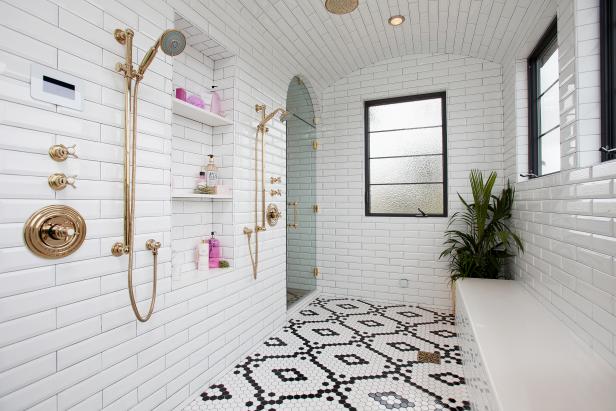Crafting the Perfect Entryway: Tile Patterns that Reflect Your Style
Posted by Mike Belk on Sep 27, 2023

Enhancing Your Entryway with Tile
The entryway of your home serves as the first impression for guests and sets the tone for the rest of your space. It's an area that deserves careful consideration and attention to detail. One way to elevate and transform your entryway is by using tile. By choosing the right tile pattern and design, you can create a stunning and welcoming entryway that reflects your personal style.
Importance of the Entryway
The entryway is more than just a space to pass through; it's a transitional area that connects the outside world to the interior of your home. It serves as a gateway, inviting both residents and guests into your personal sanctuary. The design and ambiance of the entryway can greatly influence the overall atmosphere of your home.
A well-designed entryway sets the stage for what lies beyond, creating a sense of anticipation and setting the tone for the rest of the house. It can make a statement about your style, whether it's traditional, modern, or eclectic. The entryway also plays a functional role by providing a place to store belongings, such as shoes and coats, and helping to keep the rest of your home clean and organized.
Using Tile to Elevate Your Entryway
Tile is a versatile material that offers endless possibilities for enhancing your entryway. It can add texture, color, and pattern to an otherwise plain space. Additionally, tile is durable, easy to clean, and resistant to moisture, making it an ideal choice for high-traffic areas like entryways.
When selecting tile for your entryway, consider the overall style and aesthetic you want to achieve. Explore different options like ceramic, porcelain, or natural stone. Think about the size and shape of the tiles, as well as the color palette. Subtle neutrals can create a timeless and elegant look, while bold patterns and vibrant colors can make a statement and add personality.
Remember to take into account the practical aspects of your entryway. Choose tiles that are slip-resistant to ensure safety, especially in wet conditions. Additionally, consider the maintenance requirements of the tile you choose. Some tile materials may require more upkeep than others, so opt for a material that suits your lifestyle and maintenance preferences.
By using tile in your entryway, you can create a visually striking and functional space that welcomes guests and sets the stage for your home. Whether you prefer classic patterns, geometric designs, or modern aesthetics, the right tile can transform your entryway into a reflection of your unique style. Explore the various tile patterns available to find the perfect fit for your entryway.

Choosing the Right Tile Pattern
When it comes to enhancing your entryway with tile, selecting the right tile pattern is essential to create a space that reflects your personal style. Before diving into the world of tile patterns, there are a few factors to consider that will help you make an informed decision. Once you have a good understanding of these factors, you can explore popular tile patterns for entryways.
Factors to Consider
To choose the perfect tile pattern for your entryway, consider the following factors:
- Style and Aesthetic: Determine the overall style and aesthetic you want to achieve in your entryway. Do you prefer a classic, traditional look, or do you lean towards modern and contemporary designs? This will guide you in selecting a tile pattern that complements your desired style.
- Space and Size: Take into account the size and layout of your entryway. Some tile patterns work better in smaller spaces, while others are more suited for larger areas. Consider how the pattern will visually impact the space and whether it will enhance or overpower the entryway.
- Durability and Maintenance: Evaluate the durability and maintenance requirements of different tile patterns. Some patterns may be more prone to wear and tear, while others may require more intensive cleaning or upkeep. Choose a pattern that aligns with your lifestyle and maintenance preferences.
- Personal Preference: Ultimately, your personal preference plays a significant role. Choose a tile pattern that resonates with you and reflects your unique taste and personality. After all, your entryway should make a statement about who you are.
Popular Tile Patterns for Entryways
Now that you've considered the factors, let's explore some popular tile patterns for entryways:
| Tile Pattern | Description |
| Herringbone | A classic pattern that uses rectangular tiles arranged in a zigzag pattern. It adds elegance and visual interest to the entryway. |
| Basketweave | This pattern creates a woven look using rectangular and square tiles. It offers a timeless and sophisticated appearance. |
| Chevron | Chevron pattern consists of V-shaped tiles that create a dynamic and eye-catching design. It brings a modern touch to the entryway. |
| Moroccan | Inspired by traditional Moroccan tiles, this pattern features intricate geometric designs and vibrant colors, adding a touch of exotic flair to your entryway. |
| Greek Key | Greek Key pattern showcases interlocking rectangular tiles, forming a continuous geometric border. It exudes a sense of timeless elegance. |
| Hexagon | Hexagon pattern uses six-sided tiles to create a honeycomb-like design. It offers a unique and contemporary look to your entryway. |
| Subway | Subway pattern uses rectangular tiles in a staggered brick-like layout. It's a versatile and popular choice, suitable for both classic and modern entryways. |
| Diamond | Diamond pattern features tiles arranged in a diagonal diamond shape. It adds a playful and visually appealing element to the entryway. |
| Plank | Plank pattern uses rectangular tiles arranged in a linear layout, resembling the look of wooden planks. It brings warmth and a rustic touch to your entryway. |
By considering these factors and exploring popular tile patterns, you can choose a pattern that enhances your entryway and reflects your unique style. Remember to take inspiration from various sources, such as fireplace tile ideas and tile shower designs, to create a beautiful and welcoming entryway that sets the tone for your home.
Classic Patterns
When it comes to tile patterns for entryways, classic designs have stood the test of time and continue to be a popular choice for homeowners. These patterns exude elegance and add a touch of timeless charm to your entryway. Here are three classic tile patterns that can enhance the aesthetic appeal of your entryway:
Herringbone
The herringbone pattern is a classic favorite that adds a sense of sophistication to any space. This pattern consists of rectangular tiles arranged in a zigzag pattern, creating a visually captivating look. The interlocking design of herringbone creates a sense of movement and can make the entryway feel more spacious.
To achieve the herringbone pattern, rectangular tiles are laid at a 45-degree angle to form a V-shape. This pattern can be created with various tile sizes, allowing you to customize the scale based on the dimensions of your entryway. Whether you opt for large or small tiles, the herringbone pattern adds a touch of timeless elegance.
Basketweave
The basketweave pattern is another classic choice that brings a touch of sophistication to your entryway. As the name suggests, this pattern resembles the interwoven strands of a basket. It typically consists of rectangular tiles paired with square tiles to create a repeating pattern.
The rectangular tiles are placed horizontally, while the square tiles are positioned vertically or vice versa. This alternating arrangement creates a visually appealing pattern that adds texture and interest to your entryway. The basketweave pattern is versatile and can be created with tiles of various colors and materials, allowing you to personalize the design to suit your style.
Chevron
The chevron pattern is a timeless favorite that adds a sense of movement and energy to your entryway. This pattern features tiles arranged in a V-shape, creating a continuous zigzag design. The chevron pattern brings a modern twist to classic elegance.
To achieve the chevron pattern, rectangular tiles are cut at an angle and positioned in an inverted V-shape. The result is a dynamic pattern that draws the eye and adds visual interest to your entryway. The chevron pattern can be created with tiles of different colors or materials, allowing you to play with contrasts and create a unique focal point.
By incorporating classic tile patterns like herringbone, basketweave, and chevron into your entryway, you can create a timeless and elegant space that reflects your personal style. These patterns add depth, texture, and visual interest to your entryway, setting the tone for the rest of your home. Experiment with different tile sizes, colors, and materials to achieve the perfect look for your entryway.
Geometric Patterns
If you're looking to make a bold statement in your entryway, geometric tile patterns can add a touch of modernity and visual interest. These patterns are known for their clean lines and intricate designs that can transform any entryway into a stylish and welcoming space. Let's explore three popular geometric tile patterns: Moroccan, Greek Key, and Hexagon.
Moroccan
Moroccan tile patterns draw inspiration from traditional Moorish designs, with their vibrant colors and intricate geometric shapes. These patterns often feature a combination of squares, diamonds, and triangles arranged in captivating arrangements. The rich colors and intricate details of Moroccan tiles can add an exotic flair to your entryway, creating a stunning focal point. These tiles are available in a variety of materials, including ceramic and cement, allowing you to choose the option that best suits your style and budget.
Greek Key
The Greek Key pattern, also known as the meander or fret pattern, is a timeless and elegant choice for an entryway. This pattern consists of interlocking geometric shapes resembling a maze or a series of keys. The continuous lines of the Greek Key pattern symbolize infinity and harmony. By incorporating Greek Key tiles into your entryway, you can create a sense of sophistication and classical beauty. These tiles are often found in neutral colors like black and white, making them versatile and adaptable to various design styles.
Hexagon
Hexagon tiles have surged in popularity due to their versatility and ability to create visually captivating patterns. The six-sided shape of the hexagon allows for endless design possibilities, from simple and subtle arrangements to complex and intricate layouts. Hexagon tiles can be used to create a variety of patterns, including honeycomb, flower petals, or interlocking shapes. These tiles are available in a range of sizes, colors, and materials, allowing you to customize the look of your entryway. Whether you prefer a classic monochromatic design or a bold and colorful statement, hexagon tiles can help you achieve the desired effect.
By incorporating geometric tile patterns like Moroccan, Greek Key, and Hexagon into your entryway, you can add a touch of modern elegance and visual interest. These patterns can transform a plain entryway into a stylish and welcoming space that reflects your unique style. Experiment with different materials, colors, and layout options to create a truly personalized entryway that leaves a lasting impression on your guests. For more tile design ideas, check out our articles on tile shower designs and tile backsplash ideas for kitchen.
Modern Patterns
When it comes to creating a modern and stylish entryway, tile patterns play a significant role in achieving the desired aesthetic. Modern tile patterns can add a touch of sophistication and contemporary flair to your entryway. Let's explore three popular modern tile patterns: subway, diamond, and plank.
Subway
The subway tile pattern is a timeless classic that has found its way into modern design. This pattern features rectangular tiles, typically in a 3:6 or 4:8 ratio, laid in a brick-like pattern with staggered joints. The simplicity and clean lines of the subway pattern make it a versatile choice for modern entryways. It can create a sense of openness and provide a sleek backdrop for the rest of your entryway decor.
The subway pattern is commonly associated with ceramic or porcelain tiles, but it can also be achieved with other materials such as glass or natural stone. The subway pattern can be used in various color combinations and orientations to suit your personal style. For more inspiration on using subway tiles in different areas of your home, check out our article on subway tile ideas for bathroom.
Diamond
The diamond tile pattern is an excellent choice for adding a touch of elegance and visual interest to your entryway. This pattern involves arranging rectangular tiles diagonally, creating a diamond-shaped design. The pattern can be achieved using tiles of the same size or by combining different sizes to create a more dynamic effect.
The diamond pattern can be particularly striking when using materials like marble or mosaic tiles. The interplay of light and shadow on the angled tiles adds depth and texture to your entryway. The diamond pattern works well as a focal point or as an accent border. It pairs beautifully with other tile patterns, such as the classic herringbone or geometric Moroccan patterns. For more ideas on incorporating diamond patterns into your home design, explore our article on tile shower designs.
Plank
The plank tile pattern is a modern twist on the traditional wood flooring look. This pattern involves laying rectangular tiles in a staggered arrangement, mimicking the appearance of hardwood planks. The plank pattern is ideal for those who desire the warmth and natural appeal of wood flooring but prefer the durability and easy maintenance of tile.
The beauty of the plank pattern lies in its ability to create the illusion of a larger space while adding a contemporary touch to your entryway. It can be achieved with tiles of various sizes and materials, allowing you to achieve the desired aesthetic. The plank pattern is versatile and can be used in both traditional and modern entryways. If you're interested in exploring more tile flooring options, check out our article on tile flooring options for living room.
By considering these modern tile patterns, you can transform your entryway into a stylish and welcoming space. Whether you opt for the classic subway pattern, the elegant diamond pattern, or the contemporary plank pattern, each choice adds its own unique charm to your entryway design. Experiment with different materials, colors, and sizes to find the perfect modern pattern that reflects your personal style.
Mixing and Matching Patterns
Creating Unique Designs
Mixing and matching tile patterns in your entryway can create a truly unique and personalized design. By combining different patterns, you can add visual interest and make a bold statement that reflects your style. Here are a few ideas to help you create your own unique tile designs:
- Contrasting Patterns: Choose two patterns that have contrasting styles or scales. For example, pair a large-scale geometric pattern with a smaller-scale classic pattern. This contrast will create a visually striking design that captures attention.
- Complementary Colors: Select patterns with complementary colors to create a cohesive and harmonious look. You can choose patterns that have similar color tones or opt for contrasting colors that create a vibrant and energetic atmosphere.
- Transition Zones: Use different patterns to define transition zones in your entryway. For example, you can use one pattern near the doorway and another pattern leading into the main living area. This visually separates the spaces while maintaining a cohesive flow.
- Focal Points: Create a focal point by using a bold and intricate pattern in a specific area of the entryway. This draws attention and adds a touch of drama to the overall design. Consider using a patterned rug or a decorative medallion as the centerpiece.
Remember, the key to successful pattern mixing is finding the right balance. Experiment with different combinations and lay out the patterns before installation to visualize how they will interact with each other and the surrounding elements. It's also a good idea to consult with a professional designer or tile specialist to ensure that your vision is translated into a cohesive and well-executed design.
Guidelines for Successful Pattern Combinations
While there are no hard and fast rules for mixing and matching tile patterns, there are some guidelines that can help you achieve successful combinations:
- Consider the Scale: Choose patterns with varying scales to create contrast and balance. Pair larger-scale patterns with smaller-scale ones to avoid overwhelming the space.
- Maintain a Cohesive Color Palette: Stick to a cohesive color palette to ensure that the patterns work harmoniously together. You can achieve this by selecting patterns that share similar colors or opt for patterns in complementary hues.
- Balance Busy and Subtle Patterns: If you have one pattern that is busy and intricate, balance it out with a more subtle and understated pattern. This helps prevent the design from becoming too overwhelming.
- Use Borders and Edging: Incorporate borders or edging tiles to visually separate different patterns and create a clean transition between them. This can help define each pattern and prevent them from blending together.
By following these guidelines, you can confidently mix and match tile patterns in your entryway to create a stunning and personalized design that reflects your unique style. Remember to explore other tile design ideas for different areas of your home, such as fireplace tile ideas and tile shower designs, to further enhance the beauty of your living spaces.



